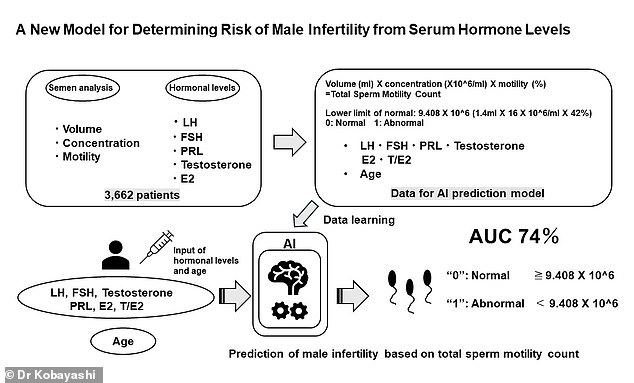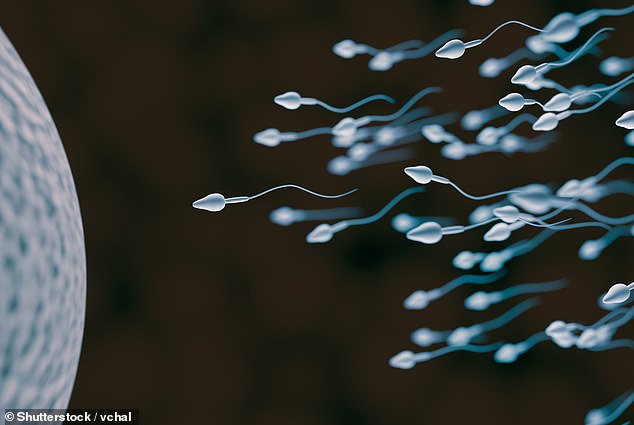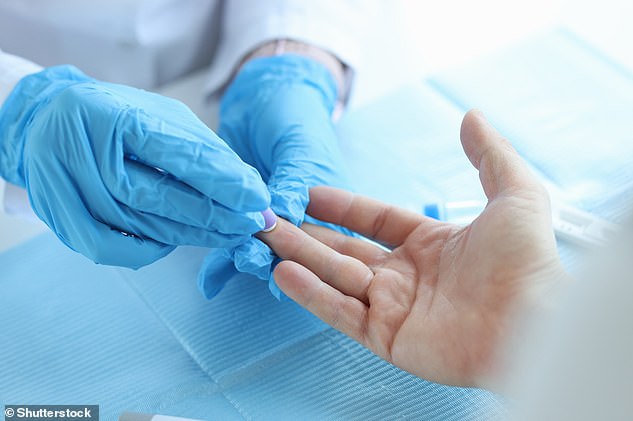GPs could soon be able to get a rapid male fertility test that requires only a blood sample, scientists say.
The test, developed by researchers in Japan, uses AI to look for hormones in a blood sample that are indicative of a low sperm count in semen.
Overall, the AI model has a 74 percent accuracy rate in detecting low sperm levels, experts say.
But it is 100 percent accurate in predicting nonobstructive azoospermia — a severe lack of sperm in the ejaculate and a leading cause of infertility.
In the near future, men will be able to prick their fingers to obtain a small blood sample, which can be sent for analysis to determine the risk of infertility.
In the future, AI-based analysis of blood samples may become an established screening method for male infertility instead of semen testing (file photo)
The test is being developed by a group led by Professor Hideyuki Kobayashi at the Department of Urology, Toho University School of Medicine in Tokyo, Japan.
“Usually the first step in diagnosing male infertility is to perform a semen analysis and if abnormalities are found, a hormone test is performed,” she told MailOnline.
‘The unique feature of this study is that it is innovative because the risk of male infertility is determined based on a hormonal test, rather than a semen test.’
“Semen testing is a simple test, but it does not adequately detect male infertility because only infertility centres have the space for ejaculation and the specialised equipment to perform the test,” Professor Kobayashi added.
‘There are also men who for social or religious reasons are unable to ejaculate through masturbation.’

This graphical summary explains the new model for determining male infertility risk from blood hormone levels.
Semen analysis is considered essential for the diagnosis of male infertility, but is not readily available in medical institutions other than those specialized in the treatment of infertility.
“Fertility specialists assume that the first step in diagnosing male infertility is to perform a semen analysis,” Professor Kobayashi added.
‘This is the world’s first AI prediction to determine male infertility risk without semen analysis.’
He trained his AI computer prediction model on data from 3,662 men who underwent semen and hormone testing for male infertility between 2011 and 2020.
From each man’s semen sample, semen volume and sperm concentration were measured.
Sperm motility was also measured – the ability of sperm to move efficiently, which is of course linked to the fertilization of an egg.
Several hormones that have been linked to high or low sperm counts in semen were also measured in the blood samples, including testosterone, follicle-stimulating hormone (FSH), prolactin (PRL), and estradiol (E2).

According to the World Health Organization, about half of all infertility cases are due to men. Semen analysis is considered essential for diagnosing male infertility, but is not available in medical institutions other than those specializing in infertility treatment (file photo)
The AI model was then validated using data from 2021 and 2022 for which semen and hormone testing were available.
Using data from 188 patients in 2021, the accuracy was about 58 percent, while the accuracy using data from 166 patients in 2022 was about 68 percent.
However, non-obstructive azoospermia (defined as the absence of sperm in the ejaculate) could be predicted with a 100 percent accuracy rate in both 2021 and 2022.
Overall, based on data from 3,662 patients, the model had an accuracy rate of 74 percent, the researchers report.
“This AI prediction model is intended solely as a primary screening step prior to semen analysis,” said Professor Kobayashi.
‘While it does not replace semen analysis, it can easily be performed in facilities other than those specializing in infertility treatment.
‘When the prediction model detects abnormal values, as patients possibly have non-obstructive azoospermia, this should be a trigger for them to undergo detailed testing at a specialist infertility clinic and receive appropriate treatment.’
Professor Kobayashi said his team has already issued a patent and is working with a company called Clear Tact Inc to commercialize the product.
“Our aim is to bring it to market within five years and I think the market will start in Japan,” he told MailOnline.
The full results have been published in the British scientific journal Scientific Reports.


